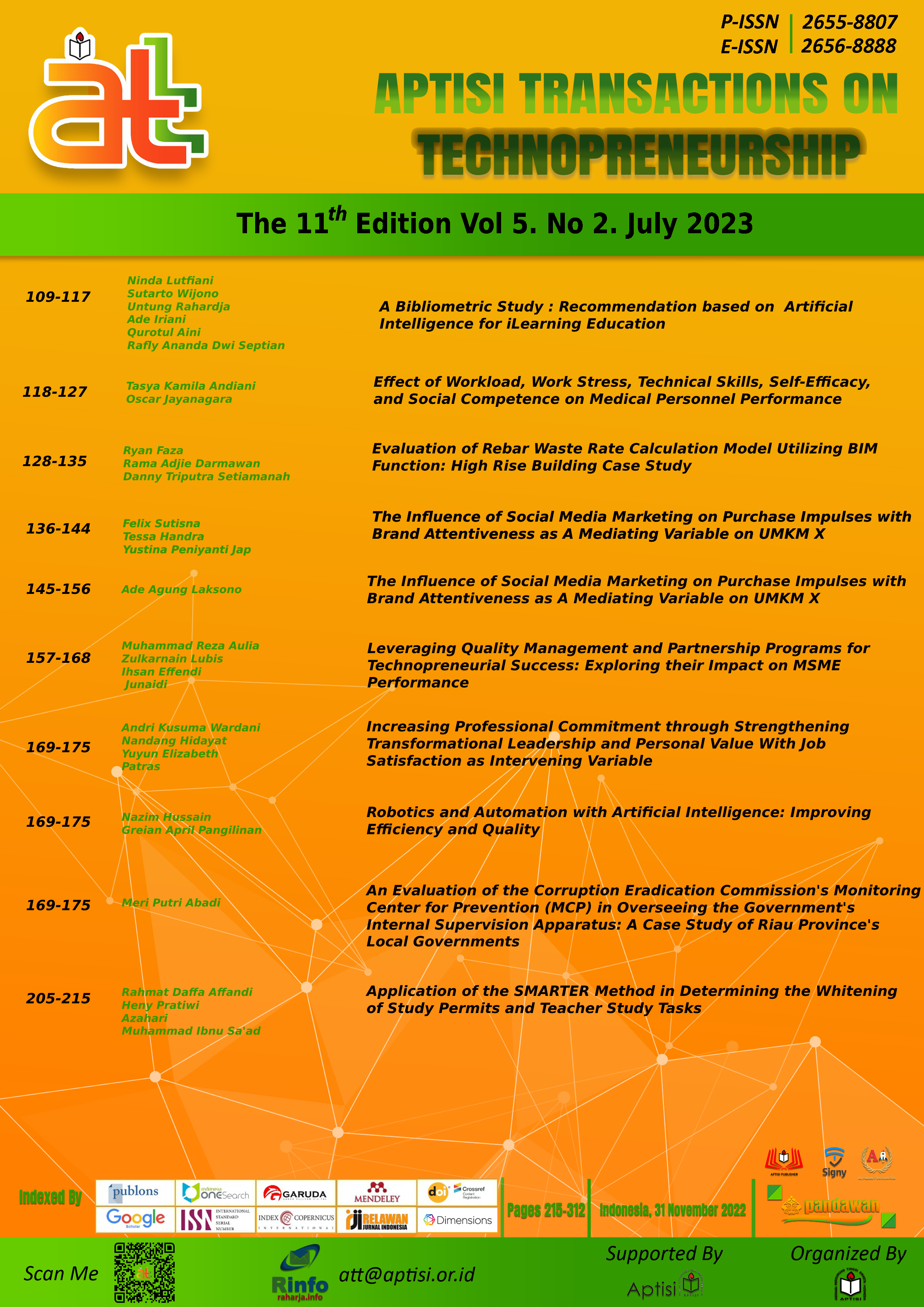Robotics and Automation with Artificial Intelligence: Improving Efficiency and Quality
Abstract
The industrial and technological revolutions are accelerating globally as a result of the widespread adoption of new information and communication technologies like artificial intelligence (AI), the Internet of Things (IoT), and blockchain technology. Government, business, and academia are all paying close attention to artificial intelligence. In this study, a selection of well-read articles on artificial intelligence from recent publications is examined. The focus of this study is to offer an analysis of artificial intelligence using integrated industry information. It provides an overview of the extent of artificial intelligence using background information, motivating factors, technological advancements, and applications, as well as rational predictions for its future. This study can contribute to the field of artificial intelligence research and offer crucial knowledge to real-world practitioners. This study's key contribution is its clarification of the current state of the art in AI for further research.
Full text article
References
R. Syed et al., “Robotic process automation: contemporary themes and challenges,” Comput Ind, vol. 115, p. 103162, 2020.
J. M. D. Delgado et al., “Robotics and automated systems in construction: Understanding industry-specific challenges for adoption,” Journal of Building Engineering, vol. 26, p. 100868, 2019.
D. O. Aghimien, C. O. Aigbavboa, A. E. Oke, and W. D. Thwala, “Mapping out research focus for robotics and automation research in construction-related studies: A bibliometric approach,” Journal of Engineering, Design and Technology, vol. 18, no. 5, pp. 1063–1079, 2020.
S. Madakam, R. M. Holmukhe, and D. K. Jaiswal, “The future digital work force: robotic process automation (RPA),” JISTEM-Journal of Information Systems and Technology Management, vol. 16, 2019.
P. Hofmann, C. Samp, and N. Urbach, “Robotic process automation,” Electronic Markets, vol. 30, no. 1, pp. 99–106, 2020.
J. Ribeiro, R. Lima, T. Eckhardt, and S. Paiva, “Robotic process automation and artificial intelligence in industry 4.0–a literature review,” Procedia Comput Sci, vol. 181, pp. 51–58, 2021.
J. Lowenberg-DeBoer, I. Y. Huang, V. Grigoriadis, and S. Blackmore, “Economics of robots and automation in field crop production,” Precis Agric, vol. 21, pp. 278–299, 2020.
F. Santos, R. Pereira, and J. B. Vasconcelos, “Toward robotic process automation implementation: an end-to-end perspective,” Business process management journal, vol. 26, no. 2, pp. 405–420, 2020.
M. Romao, J. Costa, and C. J. Costa, “Robotic process automation: A case study in the banking industry,” in 2019 14th Iberian Conference on information systems and technologies (CISTI), IEEE, 2019, pp. 1–6.
J. Siderska, “Robotic Process Automation—a driver of digital transformation?,” Engineering Management in Production and Services, vol. 12, no. 2, pp. 21–31, 2020.
M. Romao, J. Costa, and C. J. Costa, “Robotic process automation: A case study in the banking industry,” in 2019 14th Iberian Conference on information systems and technologies (CISTI), IEEE, 2019, pp. 1–6.
F. Huang and M. A. Vasarhelyi, “Applying robotic process automation (RPA) in auditing: A framework,” International Journal of Accounting Information Systems, vol. 35, p. 100433, 2019.
V. Kaul, S. Enslin, and S. A. Gross, “History of artificial intelligence in medicine,” Gastrointest Endosc, vol. 92, no. 4, pp. 807–812, 2020.
N. Berente, B. Gu, J. Recker, and R. Santhanam, “Managing artificial intelligence.,” MIS quarterly, vol. 45, no. 3, 2021.
L. Chen, P. Chen, and Z. Lin, “Artificial intelligence in education: A review,” Ieee Access, vol. 8, pp. 75264–75278, 2020.
P. Malik, M. Pathania, and V. K. Rathaur, “Overview of artificial intelligence in medicine,” J Family Med Prim Care, vol. 8, no. 7, p. 2328, 2019.
D. Gunning and D. Aha, “DARPA’s explainable artificial intelligence (XAI) program,” AI Mag, vol. 40, no. 2, pp. 44–58, 2019.
F. P. Oganda, U. Rahardja, Q. Aini, M. Hardini, and A. S. Bist, “Blockchain: Visualization of the Bitcoin Formula,” PalArch’s Journal of Archaeology of Egypt/Egyptology, vol. 17, no. 6, pp. 308–321, 2020.
G. Briganti and O. Le Moine, “Artificial intelligence in medicine: today and tomorrow,” Front Med (Lausanne), vol. 7, p. 27, 2020.
P. A. Sunarya, U. Rahardja, L. Sunarya, and M. Hardini, “The Role Of Blockchain As A Security Support For Student Profiles In Technology Education Systems,” InfoTekJar: Jurnal Nasional Informatika dan Teknologi Jaringan, vol. 4, no. 2, pp. 203–207, 2020.
R. Macrorie, S. Marvin, and A. While, “Robotics and automation in the city: a research agenda,” Urban Geogr, vol. 42, no. 2, pp. 197–217, 2021.
C. Zhang and Y. Lu, “Study on artificial intelligence: The state of the art and future prospects,” J Ind Inf Integr, vol. 23, p. 100224, 2021.
M. Budiarto, S. Maesaroh, M. Hardini, and A. Djajadi, “Future energy using blockchain systems,” in 2022 International Conference on Science and Technology (ICOSTECH), IEEE, 2022, pp. 1–9.
Authors
Copyright (c) 2023 Nazim Hussain, Greian April Pangilinan

This work is licensed under a Creative Commons Attribution 4.0 International License.
This journal permits and encourages authors to post items submitted to the journal on personal websites while providing bibliographic details that credit its publication in this journal.
Authors are permitted to post their work online in institutional/disciplinary repositories or on their own websites. Pre-print versions posted online should include a citation and link to the final published version in Journal of Librarianship and Scholarly Communication as soon as the issue is available; post-print versions (including the final publisher's PDF) should include a citation and link to the journal's website.

